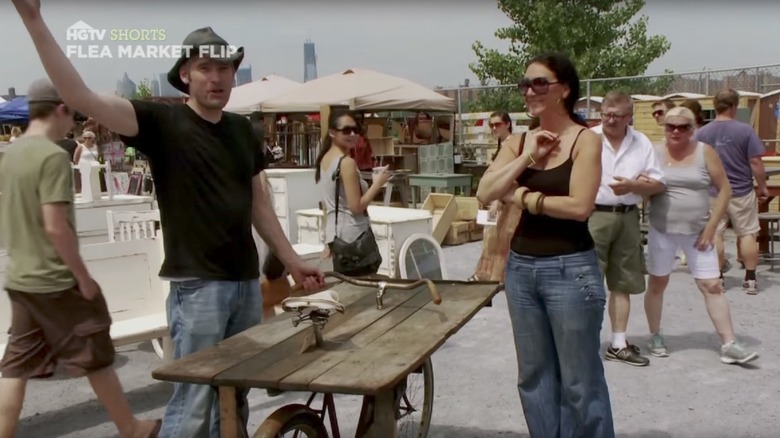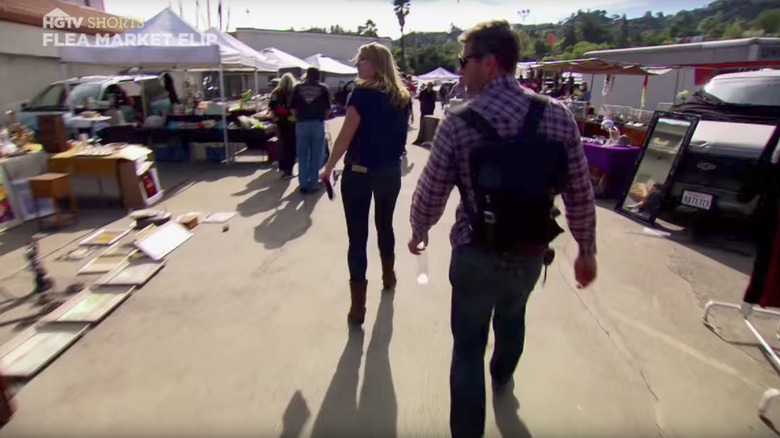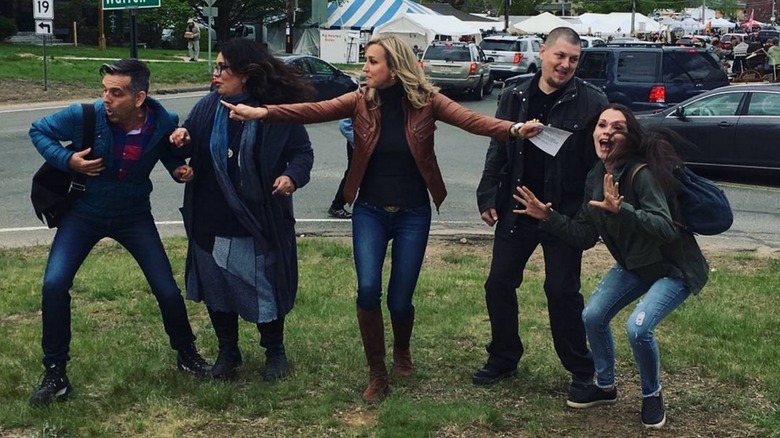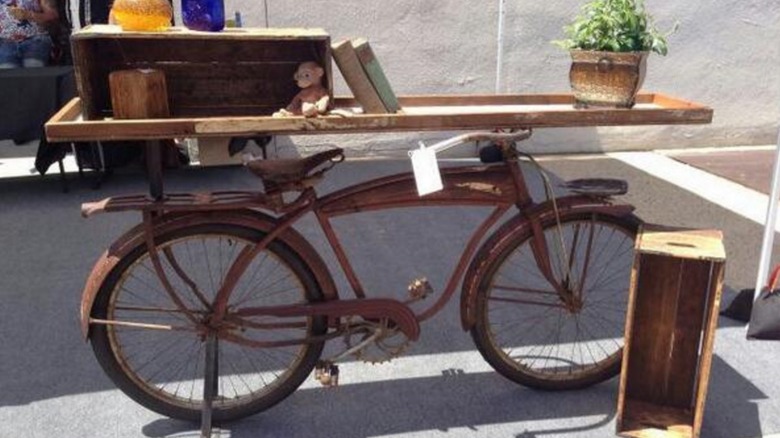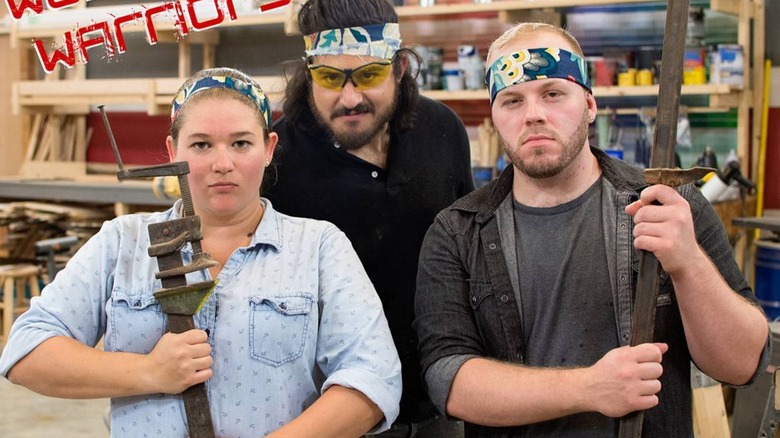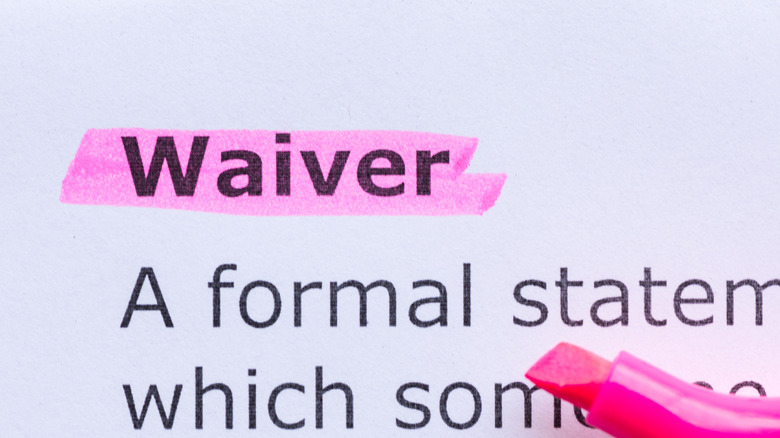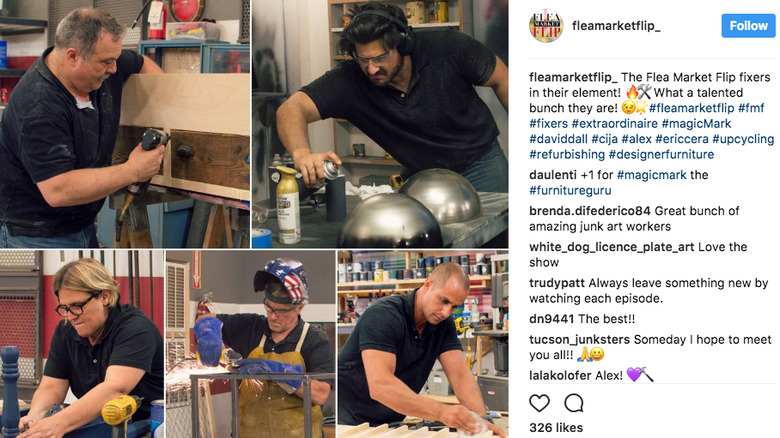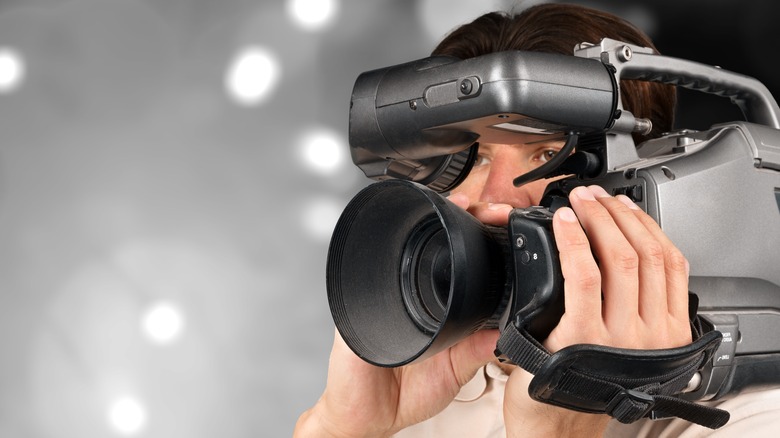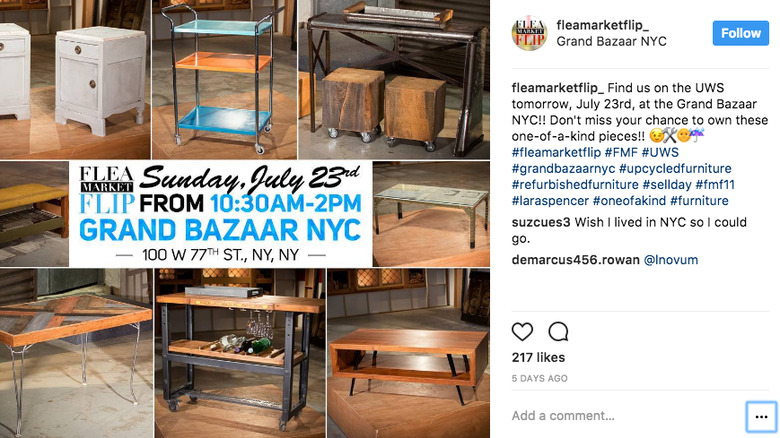The Truth About Flea Market Flip
Here's the premise: two teams of two are given a limited amount of time and 500 bucks to buy three pieces of furniture at a flea market. They take one day to completely rehab them and transform them, according to a rotating set of assigned design themes, into something creative and new, and then try to make the biggest profit by reselling them at a flea market the next day. Whoever makes the biggest profit wins a cool $5000 prize.
Sound interesting? It is! If you're design-obsessed like me, HGTV's Flea Market Flip provides an excellent opportunity to relax with a glass of wine in your hand, and spend 30 minutes alternately shouting at the TV (and your watching partner) about what you would do differently, or about how awesome something looks.
If you're looking for new HGTV shows to watch after you've cycled through every episode of Fixer Upper and Property Brothers, then I highly recommend FMF. Over the years I've seen most of the episodes, and even though the narrative follows the same basic formula over time, the creative details mean I never get bored as a viewer. And if you're already a fan of the show, you'll definitely want to hear some of these secrets and juicy tidbits I dug up about the previously untold truths of Flea Market Flip.
Host Spencer also co-hosts Good Morning America
The host and executive producer of Flea Market Flip, Lara Spencer, is not only a great designer in her own right, and a warm and compelling HGTV host, she was also a major national TV personality even before the show. Spencer was promoted to the coveted role of Good Morning America co-anchor along with Robin Roberts, and George Stephanopoulos. Previously, she was the show's "lifestyle anchor," and even before that, she worked with Good Morning America as a national correspondent between 1999 and 2004. She's certainly no stranger to the camera.
Besides her lengthy experience in TV journalism, Spencer is also a self-styled expert of the furniture flip, and is the author of two successful books on the topic: I Brake for Yard Sales: and Flea Markets, Thrift Shops, Auctions, and the Occasional Dumpster published in 2012, as well as 2014's Flea Market Fabulous: Designing Gorgeous Rooms with Vintage Treasures.
Each episode takes three days to shoot
Furniture store owners and season four, episode seven winners, Sarah and John Trop, opened up in detail on Sarah's popular DIY blog, FunCycled, about what it was like to be on the show. Sarah dished lots of juicy tidbits on the behind-the-scenes filming practices, sharing that each episode is shot over three days. The first day of filming is the shopping day. This takes place at a rotating number of low-price flea markets and antique malls in more rural areas away from New York City, like Brimfield Antique Flea Market in Brimfield, Massachusetts, or Elephant's Trunk Flea Market in New Milford, Connecticut.
The second day of filming is the "build day," where contestants have help from professional furniture builders to make their designs into reality on the quick. As Sarah wrote about her day two, "We had a master carpenter and a welder/builder that helped us most of the day...You have about 12 hours to finish the projects. We arrived at the workshop at 9 am and worked straight until 9 pm."
The third and last day of filming, the "selling day," takes contestants and their wares to the popular New York City flea market, Long Island City Flea & Food, where teams try to lure in big city buyers with deep pockets. Sara described "unwrapping" and "staging" their finished pieces, and hustling to sell them for more profit than her opponents.
Contestants sometimes get a sneak peek
Flea Market Flip winner, Sarah Trop divulged the fact that multiple episodes of the show are filmed at one time. So, on "shopping day," the two teams for each episode all receive an hour each to go through the market on-camera, and make their purchases. However, as Sarah said she had read on the blogs of past contestants, "You usually get time to look through the flea market to get an idea of what pieces you would like to buy before filming starts."
When Sarah and her husband John learned that they were "the first team up for filming," that meant they "had no time to check out the flea market" first. So what did she do? She "asked the producer if we could run it for like 10 minutes to get an idea of which direction even had furniture, [since] every other team would have time to look as they waited for their turn to be recorded. They gave [the Trops] 10 minutes and [they] ran!"
But while contestants seem to get more browsing time than ends up airing on TV, Sarah did mention that before their official hour countdown starts, contestants "can't talk to any vendor for any reason," and can "just look."
Most of the teams are married or related
No, there's no rule that the people on the competitive teams of two need to be married or related, but they almost always are, as you can see on the HGTV website's episode guide. With some exceptions, like "childhood best friends" on season eight, episode one, or flight-attendant co-workers on season six, episode four, most teams are couples in real life, sisters, brothers, mother and daughter, or father and son.
It's just speculation, but maybe that's because you have to be pretty close to start with, in order to really trust and work well together in such a fast-paced, high-stress challenge!
The host's favorite flip involved an antique bicycle
In an interview with SheKnows, host Spencer responded to a question about "the craziest item she's seen flipped," by saying she was once "completely blown away" by contestants who purchased an antique bicycle and completely rehauled it in one day into "the most fabulous tavern table."
You have to respect that kind of creativity, even if few people are clamoring to buy a bicycle table. "It was one of a kind. It was so chic, totally unique, and I would've never thought of it," said Spencer. Well, I say anyone who can transform a bike into a piece of furniture deserves to be on TV.
An upswing in the trash talk
As the show piles on season after successful season, contestants are starting to see what has worked for past contestants, using that information to become even more competitive. Spencer told Parade that the resulting team-to-team "trash-talking, no pun intended, has also heated up exponentially," as a result.
If you've seen the show (and I most certainly have), you can tell it usually features a little light-hearted rivalry. Still, newer contestants of more recent seasons are "incredibly talented," Spencer said. "They know what they are looking for at the flea market, negotiate like nobody's business, and some of the transformations they come up with are incredible."
So is the intensifying "trash-talking" a result of pure competitiveness, or is it encouraged by the producers? While Spencer didn't say, she did explain, "These teams have seen the show so they have their own take on how they'll win and they are super competitive."
The flea market sellers have to sign a waiver before contestants can buy their wares
The negotiations you see happening during the "buying period" when contestants are looking for their raw materials to upgrade and refurbish may not end up on the screen exactly the way they happened in real life. As former contestant Sarah Trop wrote on her blog, Funcycled, any of the flea market sellers they wanted to buy from had to first agree to have their likenesses shown on the HGTV network.
"They have to stop to have the people selling at the flea sign waivers saying they would be on TV," she explained, "and stop to film from different angles and have us explain why we bought what we did." So while you may see what appears like a heated negotiation on the final cut of the show, it seems that everyone involved already knows that they're going to make the deal in the end.
Contestants actually have a while to plan how they want to rehab their pieces
Nowhere in the show does anyone actually say how long they have between buying their raw flea market finds and actually executing their rehabilitations in the workshop. Maybe it's just all my experience watching shows like Project Runway or Top Chef where contestants are on lockdown with tight deadlines that made me assume very little time to plan would be part of Flea Market Flip's structure.
But it turns out contestants can find themselves with several days (or more) to ruminate on what their designs and strategy will look like. According to a design blog run by former season three, episode one contestant, Charlotte Smith, At Charlotte's House, she and her partner Jill waited "4 days" at home between buying their pieces and getting their hands dirty in the workshop. The exact filming schedule seems to be determined by a producing schedule, rather than strict timing rules.
The helpers in the workshop sometimes do most of the actual craftsmanship
You probably know from watching the show that each team has "helpers" in the workshop on build day to assist them in making their design dreams a reality. But it turns out that these expert craftsmen sometimes take the lead on what actual work needs to be done. On her workshop day recap blog post, former contestant Charlotte Smith wrote that the helpers (Cija and Mark) actually "did a lion's share of the work."
In particular, Smith wrote that she and her partner Jill did most of the rehabbing on a bench (except using the table saw), which was one of their three pieces, while "expert Mark took the reins on [rehabbing their] settee... [doing] a million percent more prep work to that thing than I would have done... he patched the wood, secured some joints, etc." And as for their third required piece, a pendant light, Smith said, "The pendant light was definitely our vision, but without Cija we could never, ever have executed it."
Finding out just how much wiggle room there is on help for the contestants may initially seem a bit disappointing, but I like to remind myself that actually executing designs isn't necessarily what the contest is about. Teams also have to make good buying decisions, think up incredibly creative designs, and then present and sell them well. It's really the total art of flipping that they're being judged on.
Host, Lara Spencer, did Kathy Griffin's interior home design
In her interview with She Knows, Spencer shared quite a few interesting tidbits about her own design background, including that her mother was her first flipping teacher ("Through osmosis, I learned through her how to spot a diamond in the rough and how to transform it," Spencer said), and that Spencer took on the interior home design for longtime friend, comedian Kathy Griffin. In fact, you can catch footage here on HGTV of the pair talking Griffin's style together.
The scenes aren't always filmed in order, so sometimes contestants fake it
Contestants on this HGTV favorite may get to flaunt their acting skills as well as their flipping skills. Like I mentioned before, multiple episodes and multiple team pairings are all being filmed on the same days, so the host and camera crews aren't always available to catch something key while it happens live. That means contestants, and even buyers, need to be prepared to "reenact" what happened for the cameras.
For example, former contestants and co-owners of the design blog, Plaster and Disaster, wrote that their entire selling day had already come to a close, and that they were sure they had lost by the time host, Lara Spencer could shoot footage with their team, writing, "...our post-selling interview was very down." Their post explains: "Lara arrived to shoot her scenes with us and we were feeling bummed, but we had to perk up and film all of the scenes for the day, including getting set up and pretending the day hadn't happened yet." Spoiler alert: They had actually won!
Sometimes fans will get advance notice of where they can go to see filming and be a buyer
Advance news of the exact time and location where the show will be filming their selling day does tend to crop up here and there. Recently, in fact, the show's official social media pages have been alerting their followers a few days before filming.
Although there doesn't seem to be a lot of regularity in the way fans are notified, they may stumble into it in places other than Instagram. For instance, that happened in a 2015 article in the Queens Courier, titled "HGTV's 'Flea Market Flip' filming at LIC Flea this weekend." The post went on to say, "Visitors are encouraged to come down to the LIC Flea for a chance to be on TV and pick up some rare finds for their homes." It seems like you have to be pretty lucky to happen to catch where they're filming in advance.
Flea market flipping into the future?
What's in store for all you new (and old) fans of Flea Market Flip? Can you count on future seasons of your new favorite furniture rehabbing show? While HGTV hasn't announced dates for future seasons beyond the current season eight, viewers can rest assured that ratings are good enough for syndication on not one, but two networks besides HGTV: DIY Network, and Great American Country.
So, fans of this Emmy-winning lifestyle show will have many more chances to see some of the amazing rags-to-riches furniture and decor flips the show is famous for. And if you'd like to see more pics of some of the coolest flips from past seasons, check out DIY Network's slideshow of some truly memorable transformations!


